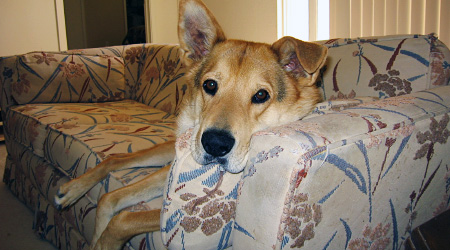5 Tips to Help Your Pet Lose Weight

The nationwide obesity epidemic has not only become an issue for adults and children, but also for family pets. Animal obesity has been exacerbated by the pet owners more sedentary lifestyle and poor eating habits. It's one thing for a human being to make poor lifestyle choices and embrace gluttony and sloth but it should be a felony criminal offense to inflict poor judgment and ill health on a beloved family pet. If you want your pet to have a long, happy and healthy life then follow the guidelines below to truly show how much you care.
1. Visit Your Vet First
Similar to medical advice provided to humans, consult with your veterinarian before starting any exercise routine or modifying your pets' current diet. While it is true that excess weight on a pet can often be attributed to overfeeding and a lack of exercise, that may not always be the case. Hypothyroidism is an example of a medical condition which can result in excess weight gain. Physical limitations, such as joint pain, may also prohibit excessive exercise and suggestions may be offered for your pet's particular situation.
2. Increase Daily Activity
Once you consult with your vet, follow their suggestions for which types of physical activity are appropriate for your pet. Severely obese animals may require shorter periods of low impact activity such as walking or swimming. In combination with reduced caloric intake, increased activity will lead to weight reduction allowing for longer periods of exercise. The key is to start slow but establish a daily routine such as a morning walk or swim in the pool.
3. Nutritional Information
Just as more nutritional information is being highlighted at restaurants and emphasized on food packaging, the same care should be used for what your pet eats. First and foremost, do not feed your pet from the table or give them human food. Many animals are unable to process foods meant for human consumption. For example, dogs are lactose intolerant and should avoid diary. They can also develop pancreatitis when consuming excessive amounts of fat. Not only that, but many foods pose a health risk from toxins, such as onions, or getting lodged in the throat as can happen with grapes. When it comes to feeding them their food, follow the directions on the packaging and then reduce it from there per your vets' recommendations.
4. Weigh Your Pet Often
In a recent study, approximately 25% of all dog owners were unable to determine their pet was overweight using visual observation alone. Just as in humans, weight on animals increases slowly over time and our visual perception of their weight gets skewed. Many vets encourage their clients to bring their pets in for weighing periodically. They will also note your animal's weight during your pets' annual shots and checkup appointment. Once you are able to start tying a number to what you see, it will become easier to make changes by increasing activity and reducing food consumption to get your pet to their ideal weight.
5. Limit Excessive Treats
Treats are junk food for pets, especially the chewy kind which get stuck on teeth causing dental issues. Animals everywhere would be better served if treat manufacturers went out of business tomorrow. It can however be quite difficult to hear a meow or see a tail wag and not want to give your furry friend a snack. If your pet is currently at the correct weight, consider giving them a few pieces of their normal food or other dry hard treat. If they are overweight try giving them celery or lettuce, at least for dogs, which provides roughage and zero calories. That way they are excited and happy because they got a treat but they will be no worse off in the long run.







